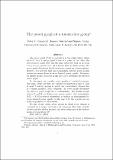The power graph of a torsion-free group
Abstract
The power graph P(G) of a group G is the graph whose vertex set is G, with x and y joined if one is a power of the other; the directed power graph P(G) has the same vertex set, with an arc from x to y if y is a power of x. It is known that, for finite groups, the power graph determines the directed power graph up to isomorphism. However, it is not true that any isomorphism between power graphs induces an isomorphism between directed power graphs. Moreover, for infinite groups the power graph may fail to determine the directed power graph. In this paper, we consider power graphs of torsion-free groups. Our main results are that, for torsion-free nilpotent groups of class at most 2, and for groups in which every non-identity element lies in a unique maximal cyclic subgroup, the power graph determines the directed power graph up to isomorphism. For specific groups such as ℤ and ℚ, we obtain more precise results. Any isomorphism P(ℤ)→P(G) preserves orientation, so induces an isomorphism between directed power graphs; in the case of ℚ, the orientations are either all preserved or all reversed. We also obtain results about groups in which every element is contained in a unique maximal cyclic subgroup (this class includes the free and free abelian groups), and about subgroups of the additive group of ℚ and about ℚn.
Citation
Cameron , P J , Guerra , H & Jurina , S 2019 , ' The power graph of a torsion-free group ' , Journal of Algebraic Combinatorics , vol. 49 , no. 1 , pp. 83-98 . https://doi.org/10.1007/s10801-018-0819-1
Publication
Journal of Algebraic Combinatorics
Status
Peer reviewed
ISSN
0925-9899Type
Journal article
Description
The second and third author acknowledge funding from the School of Mathematics and Statistics for summer internships during which this research was carried out.Collections
Items in the St Andrews Research Repository are protected by copyright, with all rights reserved, unless otherwise indicated.

